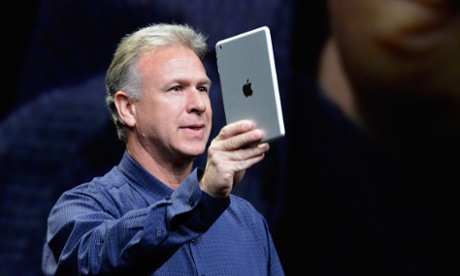
On 23 October, Apple announced the widely expected iPad mini. The company also surprised most by also introducing a faster "4th generation" iPad, swiftly replacing the one launched on 7 March this year, seven-and-a-half months ago.
That same day, Tim Cook proudly proclaimed a an iPad milestone: 100m shipped since its April 2010 debut. Impressive.
No less impressively, Wall Street analysts quickly did their subtractions and concluded Q4 iPad shipments â€" to be officially announced two days later â€" were going to miss expectations.
They were right.
Where seers expected somewhere between 15m and 16m iPads, the actual Q4 number was 14m. Using the Average Selling Price (ASP) we'll discuss in a moment, a "miss" of 2m units translates into more than $1bn (£622m) in missed revenue.
Compared to the 17m iPads shipped in Q3 (ending in June), Q4's 14m units look like a steep decline. This isn't in keeping with the fast growth the iPad had shown since its 2010 beginning. On a "Quarters After Launch" basis, the iPad used to grow faster than the iPhone. Now, we see a decline from the 15.4m units shipped in Q1 (ending December 2011), and only a modest 26% increase from last year's Q4. Where are the go-go days of 70% or even 100% year-to-year growth?
Two days later, at the 25 October Earnings Conference Call, Apple's CEO tried to put a better face on that strangely anemic 26% growth. As noted by Horace Dediu, Tim Cook pointed to a different number: sell-thru, units actually delivered to customers, grew by 44%. Not great, but not as tepid as 26%.
(See Philip Ellmer-Dewitt's detailed explanation here. In essence, when a product ships, it "changes hands": the channel partner "takes title", meaning it moves from Apple's books to the reseller's. For Apple, the items thus shipped count as revenue, even if they're not sold-thru â€" that is, sold to end customers. When the volume of products Apple ships to retailers is less than the volume sold-thru, channel inventories decline, more sales out than shipments in. This is how Apple sees revenue go up by 26% while sell-thru increases by 44%. A likely explanation for last quarter's depletion of channel inventory is making room for the two new iPad models.)
Resorting to sell-thru numbers as a way to put iPad numbers in a better light could be habit-forming; it could force Apple's management to provide more detailed inventory numbers more regularly.
On the end-customer demand side, Apple execs attributed the low Q4 iPad number to several months of intense and detailed rumors ahead of the iPad mini launch.
So, the iPad story could look this: last year, the yearly iPhone refresh moved from June to October; as a result, Q4 iPhone shipments disappointed; but fast growth resumed once the new model shipped; the pattern now applies to the iPad as well.
No, the iPhone and the iPad behave more differently than in the above scenario. I went back to SEC filings and extracted data for the following graph tracking iPhone and iPad ASP's for the past eight quarters:
The iPhone ASP is stable. Carriers keep indulging in (wooden) sabre-rattling, complaining about "excessive" iPhone subsidies. Here, subsidy means the difference between the price carriers pay for a handset and the typical end-user price: $199 for the phone with a two-year contract. In such a $199 arrangement, for the past five years, Apple has been able to extract more money from carriers than any of its competitors. Paraphrasing Horace Dediu, the explanation for such an enduring advantage is a simple one: for carriers, the iPhone is a better salesman, it generates more revenue, a higher ARPU (Average Revenue Per User). As a result, carriers pay the iPhone salesman a higher commission, meaning a higher handset price. (And they sound like the grouchy bosses who complain their star sales person makes too much money…)
For the iPad, there is no such arrangement, no two-year contract, no subsidy. For example, AT&T will sell an iPad with a no-commitment, month-to-month wireless data contract. Without a two-year commitment, carriers have no incentive to sell the iPad at a particularly attractive price, causing customers to face the price without a subsidy fig-leaf. (One might argue smartphone contracts lead customers to borrow money, the $400+ subsidy, at usurious rates, but such habits are hard to break. Rare is the carrier that will offer a cure, a lower monthly contract if you pay full price for the phone.)
How do iPad customers react to the cold price truth? All we know is the ASP has been falling for five quarters. And we can also surmise price figures more actively in competitive situations than it does with smartphones. Or, for that matter, with notebooks and desktop computers: ASP for Macs is stable or growing a little, from $1,282 last year to $1,344 last quarter. These prices don't prevent Apple from being number one on desktops and notebooks in the US â€" as Tim Cook reminded everyone on 23 October.
The surprise iPad refresh can be seen as a reaction to competitive pressures, existing or upcoming ones. And, for the iPad mini, we have an interesting combination: premium price and an avowed lower gross margin, "significantly below our cooperate average" says Apple's CFO during the 25 October Earnings Conference Call.
The iPad definitely behaves differently â€" neither a bigger smartphone, nor a smaller PC, thus confirming it belongs to a new category whose rules are still being established. The next few quarters will be even more interesting than recent ones: Google, Amazon and Microsoft have new products worth watching, they all intend to fight for a dominant role in the new space.

No comments:
Post a Comment